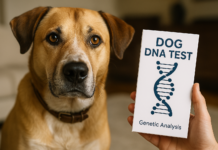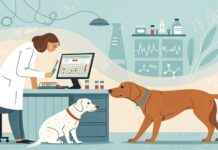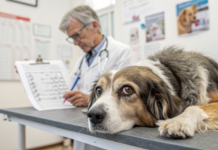Last Updated on January 3, 2021 by Dogs Vets
Can Dogs Eat Cake?
Consider this again before you give your dog a big piece of cake for his or her birthday. So you’re hosting a pet birthday party, or your beloved dog has made another trip around the moon, and of course you want to honor your favourite furry friend. So you gather your friends (and their dogs) and put together a lovely day for your human and canine friends, with a menu filled with delicious dog food and, of course, some appetizers for humans.
Feeding your dog Birthday cake, right? Wrong. Never you give your dog birthday cake.

One of the key ingredients in both cake and frosting is bad news for your dog: for dairy products, Dogs have a hard time breaking down the enzymes, and eating milk, cream, or butter can lead to severe vomiting and diarrhea. That is not going to be a fun birthday for your dog!
See also: Can Dogs Eat Apples? – Top 10 Fruits dogs can and can not eat
In addition, common cake ingredients and add-ons are also unhealthy and potentially deadly to doggos. Chocolate, nutmeg, raisins and macadamia nuts can seriously affect your dog’s health and should never be fed to them.
So if you’re planning your dog’s birthday party (or celebrating your own big day with your best pet doggie friend), just try to stick to plain old doggie treats and maybe some peanut butter. Your dog will love it more anyway!
Here are the Top 5 reasons you should not feed your dog with cake
1. The excessive sugar content may cause weight gain and obesity.
Due to its ingredients, the cake is loaded with sugar, which is not healthy for your dog. If you give your dog cake regularly, your dog will gain weight over time and may become obese. Weight gain and obesity lead to other serious health complications such as arthritis, heart disease and diabetes.
2. Too much cake is detrimental to dogs’ dental health.
Cake for Dogs Even if you brush your dog’s teeth daily, eating high-sugar items like cake can affect a dog’s oral health. Bad breath, bacterial infections, rotting teeth, and cavities are not only serious problems, but can also promote the development of other health concerns in your dog’s body.
3. Bacterial infections
Bacterial infections from the mouth can enter the bloodstream and spread throughout the dogs body. From there, the infection can cause significant damage to the heart, brain, lungs, liver and kidneys. In extreme cases, the infection can lead to death.
4. Some cake ingredients and toppings are dangerous to dogs.
Ingredients commonly used in a variety of cakes can be toxic to dogs even in small amounts. Here are some things to look for in cake before feeding it to your dog:
- Chocolate
- Grapes
- Coffee
- Macadamia nuts
- Grapes
- Vanilla extract
- Nutmeg
- Sweets
Because of these multiple dangers associated with cake, it is best not to make it a regular part of your dog’s diet.
5. Sugar-free cake is not a healthy solution.
Some dog owners may think that feeding their dog a piece of sugar-free cake is acceptable. It doesn’t contain added sugar, right? It’s true, but replacing sugar is a big danger for dogs health.
Xylitol is a common sweetener used to replace sugar in a variety of foods. As a sugar alcohol and natural sugar substitute, xylitol has become increasingly popular, especially in low-calorie, sugar-free foods. Unfortunately, this sweetener is toxic to dogs and it doesn’t take too much to cause serious medical problems for your pet.

Even a small amount of ingested xylitol can stimulate insulin release in a dog and cause a rapid drop in blood sugar or hypoglycemia. The result is a dog that lacks coordination, weakness, coma, seizures, and in the worst case, death.
Summary and conclusion
Can dogs eat cake?dog cake, can dogs eat cake frosting, can dogs eat strawberry cake, can dogs eat cake without icing, can dogs eat sponge cake, can dogs eat chocolate cake, can dogs eat red velvet cake, can dogs eat cupcakes ? Now you already know that cake is not a nutritious or healthy food for anyone, and it is not a treat you should give your dogs.
However, an occasional piece of cake will in all likelihood not harm a dog. Since every dog has different and individual sensitivities, it is best not to take any chances.
Don’t give your dog any part of the cake that is meant for humans. Instead, buy or bake a dog-friendly cake with appropriate ingredients that your pup can safely eat.
See also: Top 7 Mountain Dog Breeds with their common Lifestyle
Fact Check
We strive to provide the latest valuable information for pet lovers with accuracy and fairness. If you would like to add to this post or advertise with us, don’t hesitate reach us. If you see something that doesn’t look right, contact us!
Reference: Thedailymeal.com

















